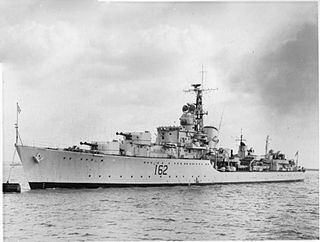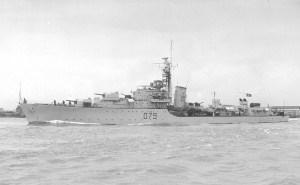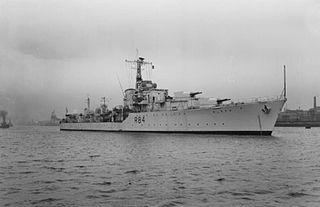
The Battle class were a class of destroyers of the British Royal Navy (RN) and Royal Australian Navy (RAN), named after naval or other battles fought by British or English forces. Built in three groups, the first group were ordered under the 1942 naval estimates. A modified second and third group, together with two ships of an extended design were planned for the 1943 and 1944 estimates. Most of these ships were cancelled when it became apparent that the war was being won and the ships would not be required, although two ships of the third group, ordered for the RAN, were not cancelled and were subsequently completed in Australia.
HMS Hogue was a Battle-class destroyer of the Royal Navy that was commissioned during the Second World War. She was named after the Battle of La Hogue, fought between the British and French in 1692; the ship's badge a chess rook on a field blue, within a chaplet of laurel gold was derived from the arms of Admiral Sir George Rooke who distinguished himself at the battle.

HMS Jutland (D62) was a later or 1943 Battle-class fleet destroyer of the United Kingdom's Royal Navy. She was named after the Battle of Jutland, the largest naval battle of the First World War. The first Jutland was launched in 1945, but was cancelled that same year. Her sister ship, Malplaquet - named after a battle between Britain and France during the War of the Spanish Succession in 1709 - was renamed Jutland just prior to her launch on 20 February 1946, and was commissioned on 30 July 1947. The original Jutland was finally broken up in 1957 at Rosyth.

HMS Finisterre was a Battle-class destroyer of the Royal Navy (RN). She was named after one of the battles of Cape Finisterre. She was the first and thus far the only ship of the Royal Navy to bear this name.

HMS Trafalgar was a Battle-class destroyer of the Royal Navy (RN). She was named after the Battle of Trafalgar, a decisive British victory over a Franco-Spanish Fleet in 1805. Trafalgar was built by Swan Hunter on the Tyne. She was launched on 12 January 1944 and commissioned on 23 July 1945.

HMS Dunkirk (D09) was a later or 1943 Battle-class fleet destroyer of the British Royal Navy (RN). Though there were other ships of the Navy that had been named Dunkirk, as far back as the 1650s, it held added meaning after the evacuation from Dunkirk between late May and early June 1940, in which over 300,000 British, as well as French troops, were rescued by a ragtag fleet of ships.

HMS Camperdown was a Battle-class destroyer of the Royal Navy (RN). She was named after the Battle of Camperdown, a naval engagement between the British and Dutch that took place in 1797, and which resulted in a British victory.

HMS Cadiz was a Battle-class destroyer of the Royal Navy. She was named after the Battle of Cádiz, in which the French besieged the Spanish town in 1810, which was eventually lifted in 1812 after the French defeat at the Battle of Salamanca.

HMS Barfleur was a Battle-class destroyer of the Royal Navy (RN). She was named after the Battle of Barfleur, which involved an Anglo-Dutch Fleet against the French in 1692.

HMS Armada was a Battle-class destroyer of the Royal Navy (RN). She was named in honour of the English victory over the Spanish Armada in 1588. Armada was built by Hawthorn Leslie and Company on the Tyne. She was launched on 9 December 1943 and commissioned on 2 July 1945.

HMS Saintes was a 1942 Battle-class fleet destroyer of the Royal Navy (RN). She and 15 sister ships being ordered under the 1942 defence estimates. The ship was named after the Battle of the Saintes, a Royal Navy victory over a French fleet intending to invade Jamaica in 1782. So far she has been the only ship of the Royal Navy to bear the name. Saintes was built by Hawthorn Leslie and Company on the Tyne. The vessel was launched on 19 July 1944 and commissioned on 27 September 1946.

HMS Gravelines was a Battle-class destroyer of the Royal Navy. She was named after the Battle of Gravelines, which took place in 1588, resulting in the English Navy defeating the Spanish Armada. Gravelines was built by Cammell Laird of Birkenhead. She was laid down on 10 August 1943, launched on 30 November 1944 and completed on 14 June 1946.

HMS Agincourt (D86) was a later or 1943 Battle-class fleet destroyer of the Royal Navy. She was named in honour of the Battle of Agincourt, fought in 1415 during the Hundred Years' War. Agincourt was built by R. & W. Hawthorn, Leslie & Company Limited on the River Tyne. She was launched on 29 January 1945 and commissioned on 25 June 1947.

HMS St. Kitts was a Battle-class destroyer of the Royal Navy (RN). She was named in honour of the Battle of St. Kitts which took place in 1782. So far she has been the only ship of the Royal Navy to bear the name. St. Kitts was built by Swan Hunter & Wigham Richardson Limited on the Tyne. She was launched on 4 October 1944 and commissioned on 21 January 1946.

HMS Solebay was a Battle-class destroyer of the Royal Navy (RN). She was named after the Battle of Solebay which took place in 1672 between an Anglo-French force and the Dutch Navy during the Third Anglo-Dutch War. Solebay was built by R. & W. Hawthorn, Leslie & Company Limited on the Tyne. She was launched on 22 February 1944 and commissioned on 25 September 1945.

HMS Roebuck was an R-class destroyer of the British Royal Navy that saw service during World War II. She was the fifteenth ship to carry this traditional ship name, after a small deer native to the British Isles, which was used as far back as the reign of Queen Elizabeth I.

HMS Zest was a Z-class destroyer of the Royal Navy that saw service during World War II.
HMS Thanet was an S-class destroyer of the Royal Navy. Built during, and commissioned shortly after the First World War, she went on to see service in the Second World War, and was sunk early in 1942.

HMS Carysfort was a C-class destroyer of the Royal Navy. She was ordered in 1941, originally under the name HMS Pique.


















